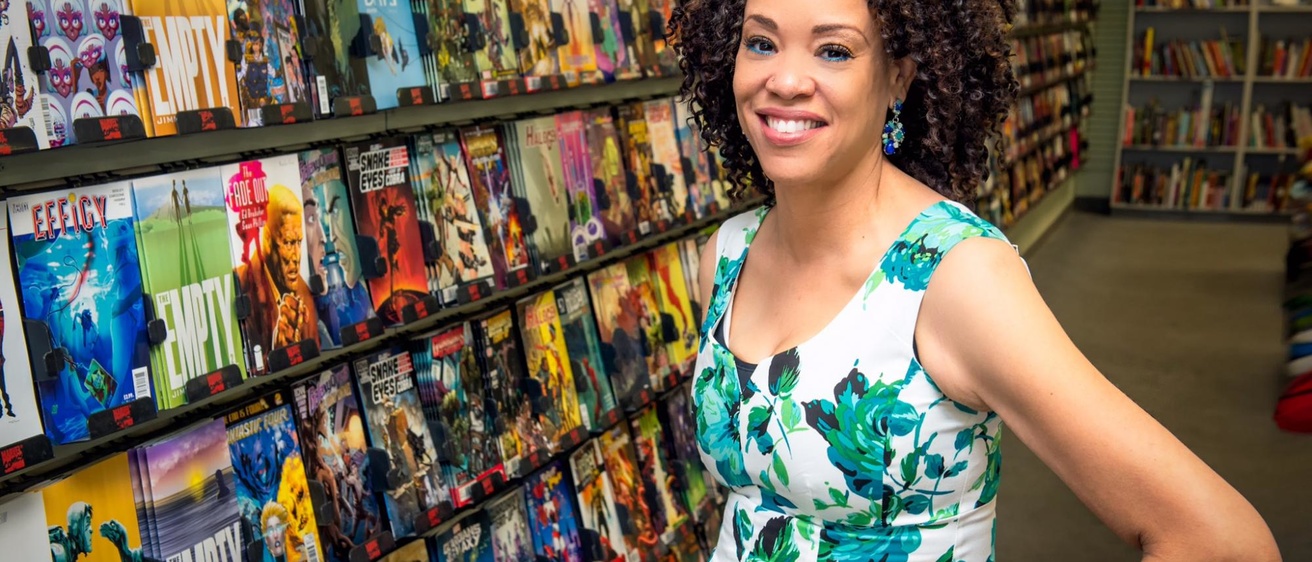University of Iowa professor Deborah Whaley's latest book, Black Women in Sequence: Re-Inking Comics, Graphic Novels, and Anime, examines the history and effects of how black women are represented in comic books, graphic novels, and animation.
Originally from Wheatridge, Colorado, Whaley received a B.A. from the University of California at Santa Cruz and a Ph.D. in American studies from the University of Kansas in 2002.
We caught up with Whaley to discuss her book, as well as her role on campus.
So what do you do at the university?
I am an associate professor in the Department of American Studies and Program in African American Studies. I teach undergraduate courses on comparative U.S. history, black cultural studies, popular culture, and film and graduate courses on interdisciplinary research methods and cultural studies. I have also taught first-year writing courses for the rhetoric department.
Take us through your most memorable day at the university.
During my first semester teaching at the University of Iowa in 2007, I taught an undergraduate seminar titled “Diversity and American Identities.” The class was relatively small, with 12 students, which allowed for intense discussion and lengthy feedback on student writing on a weekly basis. Our class sessions were magical. On one of the last few days of the semester, we had a terrible snowstorm, and I was not sure how many students would attend, given that our class was 9:30 in the morning. Just in case, I stopped off at the store and bought Starbucks drinks, juice, and pastries to thank those who would weather the storm and be in attendance. When I arrived to class with my heavy bag of books, folders, and goodies, I was so happy to see every enrolled student in the classroom, ready and willing to engage like every other class session. I was really touched by their dedication to the class and happy to see how much the class meant to the students, which many expressed to me that snowy morning. Given that it was my first semester, it really set the atmosphere and tone for my teaching experience at Iowa. The next time I taught the course, I had 27 students.
What inspired you to write Black Women in Sequence: Re-inking Comics, Graphic Novels, and Anime?
The inspiration came from my experience as an artist and as a consumer of comic art in print—for example, in newspapers, comic books, and graphic novels—and in moving-image form, like TV and film. I wanted to shift the conversation about comics to assert the importance of comic scholarship and dispel the false idea that comics are primarily a medium for children, though I find comic art directed at children equally important and as rich texts for learning. I wanted to provide an opportunity for a wide audience to learn about the representations, consumers, and creators of the black female image in comic books, comic strips, graphic novels, anime, video games, TV, and film and to discuss why those images matter.
What does Black Women in Sequence do differently than other studies on comic books?
It is the first book-length study on black women in a wide range of comic art. Before my book, there was little scholarship on the topic, even in scholarly-article form. While there are certainly many books on comics in general and a handful on the black image in comics, this is an interdisciplinary analysis of comics that illustrates how sequential art reflects history, culture, and politics from the early 20th century to contemporary times. I discuss popular characters like The Butterfly, Vixen, Nubia, Storm, Friday Foster, Martha Washington, Nadia, and Catwoman, as well as the work of artists Jackie Ormes, Afua Richardson, Leisl Adams, Nara Walker, Ashley Woods, and Rashida Jones.
Would you ever consider writing a comic book or graphic novel of your own?
Yes. I am an artist, and I often sketch and paint images of comic book characters or art influenced by the simplistic lines and performative aspects of sequential art. I am discussing with a colleague the prospects of doing a collaborative comic series about a black female professor and her ongoing adventures as a superheroine within and beyond the walls of the ivory tower.
If you could spend a day with anyone, from any era, who would it be and why?
Jackie Ormes, who is noted as the first black female cartoonist; she did work in the 1930s through the 1950s. I would love to talk with her about her artistic inspirations, what she thought about formal arts training vs. being a self-taught artist, her feelings about U.S. and international politics, and how she felt being subject to surveillance by the U.S. government for her activism and, as many suspect, the political leanings of her comic art. She has an FBI file that is more than 200 pages, which I talk about in my book.
If you could have a song written about you, who would perform it, and what would it be called?
It has already been written: Peter Murphy’s “Time Has Nothing to Do with It.”
What are some of your favorite things?
- Swimming
- Yoga
- Good vegetarian and vegan dishes
- The Flash, Gotham, and Daredevil TV series
- Netflix
- The Golden State Warriors
- Traveling to New York City
